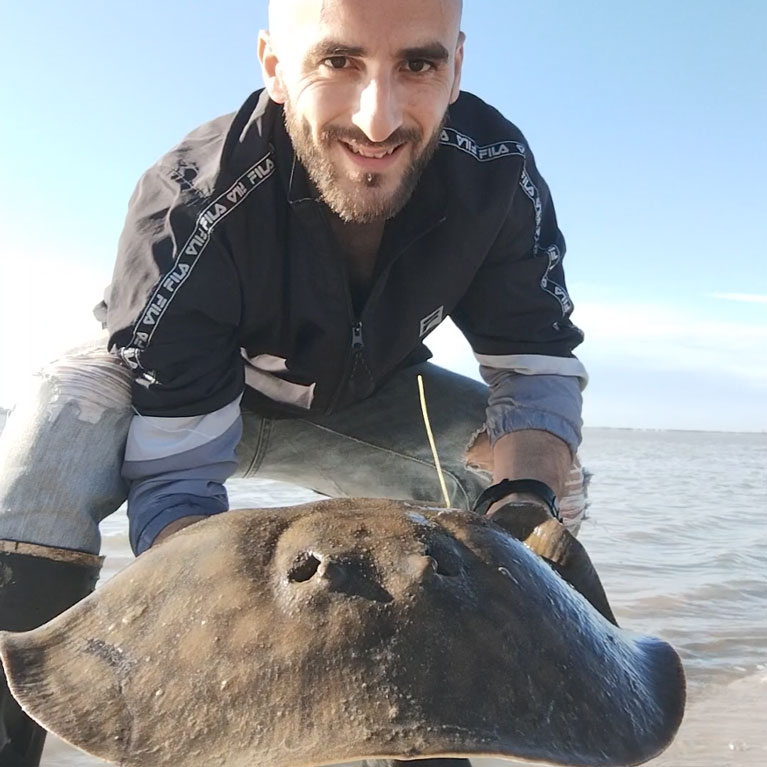Giant stingrays of the Paraná River
As the world’s only exclusively freshwater chondricthyan, the giant freshwater stingray is remarkable – and increasingly rare. With high fishing pressure and no protection measures in place, the need for conservation intervention is critical. Diego is tagging giant freshwater stingrays in the middle and lower Paraná River to determine their seasonal migrations and habitat use and the extent of individual movements in the river system. By understanding their movement patterns, Diego can help guide where to focus conservation efforts – a crucial component of an effective conservation plan. His goal is to ensure that these amazing creatures, unique to the rivers of central South America, have a fighting chance to survive.
I grew up in Barker and Villa Cacique, two small towns in the south of Argentina’s Buenos Aires province. The picturesque landscapes and imposing mountain ranges of these places drew me to the enchantment of nature from an early age. My family and I often explored rural paths and climbed hills that offered breathtaking views, journeys that enabled me to spend delightful days learning about flora and fauna. During family vacations to the beach, I became captivated by the sight of fishing boats unloading sharks and rays. These creatures always intrigued me and I envisaged a future working...
Unveiling seasonal movements for effective management strategies: engaging fishermen in conservation of giant freshwater stingray
The main objective of the project is to understand the movement patterns of giant freshwater stingrays in the middle and lower Paraná River by engaging local fishers in a stingray-tagging programme, and to identify the appropriate spatial and temporal scale for conservation and fishery management of this species.
This project will fill a gap in the knowledge of the giant freshwater stingray, the world’s largest exclusively freshwater elasmobranch. Urgent action is needed, as this remarkable species faces intense fishing pressure with limited biological productivity within a confined geographic range, and no protective measures exist. By involving fishers in our tagging programme, we aim to contribute to the implementation of effective conservation strategies and responsible fishery management of this unique freshwater giant, and also to raise awareness about elasmobranch conservation.
In recent years there has been a burst of new knowledge about Neotropical freshwater stingrays. These fascinating creatures are found in rivers across South America. Surprisingly, even though we now know more species exist, we still lack crucial information about their biology. This is especially true in Argentina, where ecological studies about these creatures are just starting to emerge. The giant freshwater stingray Potamotrygon brachyura is the largest of its kind in the Neotropics. It is found in the Río de la Plata and the Paraná (middle and lower sections), Paraguay, Uruguay, Bermejo and Pantanal rivers. In certain areas, populations of this species are exposed to habitat alteration; in others, overfishing is a more serious threat. Research has shown that the species is declining in part of its range and it is particularly vulnerable due to its low reproduction rate, which means it cannot recover quickly from overfishing. Yet, despite this worrying trend, there are no regulations in place to protect this stingray. Taking its reduced geographic range into consideration, its situation becomes even more worrying. A combination such as this – a declining population trend, heavy fishing pressure and low biological productivity in a species with a reduced global geographic range and no fishing regulations – requires urgent and effective science-based management. So what is the plan? By studying the movement patterns of giant freshwater stingrays, we can work out where they go and where to focus our efforts. This information is crucial for creating effective conservation plans. The goal is to ensure that this amazing species, unique to the rivers of central South America, has a fighting chance to survive.
- To conduct a comprehensive study of the movement patterns of the giant freshwater stingray in the middle and lower Paraná River, using conventional tagging techniques, in order to determine its seasonal migrations, habitats used and extent of individuals’ movements within the river system.


